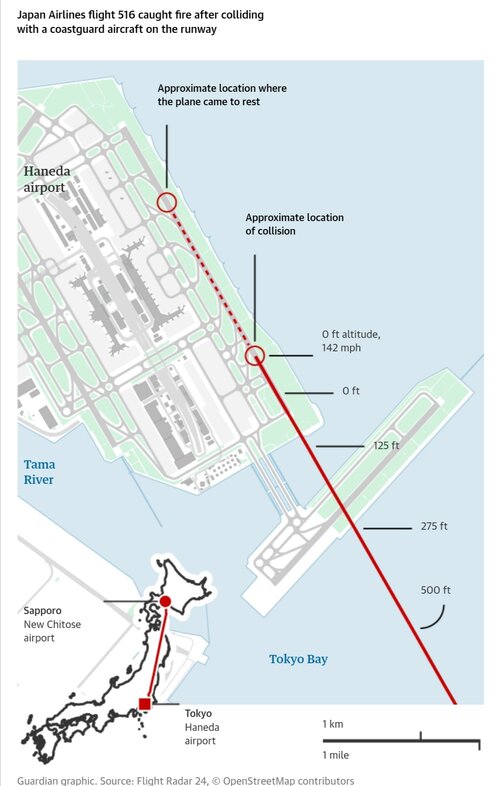blackkite
Don't laugh, don't cry, don't even curse, but.....
- Joined
- 31 May 2007
- Messages
- 8,581
- Reaction score
- 6,774

A total of five people who were on a coast guard aircraft at Tokyo’s Haneda airport have died as a result of a collision with a passenger plane, police confirmed, according to public broadcaster NHK.
Six people were on the coast guard aircraft, a Bombardier Dash-8, which was part of earthquake relief efforts.

A few years ago, we had the chance to ride with the fire crew at El Paso and their equipment includes a boom mounted probe that is stabbed into the fuselage to put water or foam within the interior. The reach is pretty significant but looking at the footage of this incident, not sure how they could get close enough without the fires on the runway being extinguished first.Yeah there were fires on the A350 before it stopped but then you see shots of the passengers coming down the escape slide during the evacuation while fuel is pouring from the wing box and the engine is shooting sparks out its rear. It really was a miracle all were evacuated.
It looks like the other fires around the plane were mostly extinguished by the fire crews relatively quickly but fire in the passenger cabin above the wingbox was out of control gradually advancing up and down the plane until it completely burnt it up from the inside out.
I suppose the question is how do you fight an internal fire like that? Can you?
|


A 47-year-old office worker from Ota ward, Tokyo, told the Yomiuri Shimbun newspaper that she had been sitting in the centre of the plane when she heard a huge thud. She looked out of the window to see smoke billowing from the wings, at which point she felt hot air around her face.
She said: “Smoke filled the cabin, and passengers shouted: ‘It’s on fire! It’s on fire!’”
Anton Deibe, 17, a Swedish passenger told the newspaper Aftonbladet that “the entire cabin was filled with smoke within a few minutes. We threw ourselves down on the floor. Then the emergency doors were opened and we threw ourselves at them”.
He added: “The smoke in the cabin stung like hell. It was a hell. We have no idea where we are going so we just run out into the field. It was chaos.”
A350 flight JAL516 destroyed in landing collision with Japanese coast guard Dash-8. All passengers evacuated safely. Airframe burns to total destruction. All coast guard crew killed but one (pilot).
Since it's probably the first such incident involving an all carbon airframe, scrutiny will be at the maximum.

Not trite... note the recommendation #7 in the FAA accident report for United Airlines Flight 232, DC-10 N1819U (1989):FWIW, the firefighters did a good job and didn't run over anybody.
Don't think I'm being trite, when I was aircrew, we always briefed to watch out for them since they are primarily focused on the burning aircraft, and I've egressed two declared fire emergencies. The direction I always had from the "graybeards" was to get away from the paved surface as fast as I could and to run in the direction of help, which I did twice. After the second time the firefighting SNCO told me that he really didn't want to see me running up a runway again...
Airport procedures and equipment: nine safety recommendations were issued on airport procedures and equipment. These recommendations addressed fire fighting vehicles and rescue/firefighting activities at accidents in crop environments on airport property.
Yes, cabin crew actions really did save all of them. See how with the rear emergency exit blocked and central com system down, a cabin filled with acrid smokes, they still managed to get them all out safely. (I guess they had to done the hoodies what could explain the slight delay in directives noted by witnesses).
I haven't seen that to be the case in emergencies.How much of that is down to the culture in Japan to be respectful and orderly ?, unlike westerners who more likely would be fighting to get their cabin bags out then photoing/videoing both the inside and outside the aircraft during the evacuation.
Make a search on internet and you can see plenty of pictures of disorderly "Asians" exiting crashed planes with their hand luggage rolling behind them.How much of that is down to the culture in Japan to be respectful and orderly ?, unlike westerners who more likely would be fighting to get their cabin bags out then photoing/videoing both the inside and outside the aircraft during the evacuation.
In the 24 hours before the collision, the Coast Guard aircraft had already made two round trips from Haneda to the quake zone, a 3.5 hour survey of the area shortly after the magnitude 7.6 quake struck on Jan 1, and a flight carrying rescue workers that returned early on Jan. 2, the official said.
